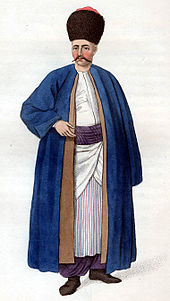Harem pants

A harem pants (also Puffhose ) is a very wide-cut, mostly by reaching to the ankle or shoes trousers ; but they were only knee-length. In the Renaissance , this form came into fashion as men's trousers. One feature was the multiple longitudinal slits through which the colored (expensive) linings came to light.
The harem pants developed in the second half of the 16th century from the Spanish army drum and spread across Europe. The Netherlands became an important center of this trouser fashion because trade with overseas countries took place through its ports. The name is said to be derived from the Middle High German "blodern", which means "well" and thus has the same origin as chatting .
To produce such a garment, at least 3.5 linear meters of cloth (mostly wool) and around 13.5 meters of valuable silk lining were required. They were very heavy with the cloth, so that the tailors increasingly switched to processing pure silk. This in turn was very expensive because it had to be imported from East Asia.
On the other hand, both church leaders and rulers competed, who demanded rather sensible clothing. A sermon by the Brandenburg superintendent Andreas Musculus was called, for example, "Vom zuuderten, breeding and honor-defying pludrichter Hosenteufel". The cantor Johann Walter composed in 1561 resignedly in " Wach auf, wach auf, du deutsches Land ":
If you don't have
harem pants that seem to hang to the ground
with villi like the devil's Wat Note,
you can't flaunt politely.
It is such a disgraceful costume,
the devil must have thought it up, so
it will be himself.
The elector even enacted his own law against the wearing of harem pants and supported this with draconian measures: he had wearers of such trousers locked up in fools' houses and mocked by the people for a day or even cut their trouser belts so that the once proud suspenders stood there in their bare shirts . Nevertheless, harem pants fashion lasted for a few decades.
Often an overcoat reaching up to the knees was worn over the harem pants and a coat over it, for example the zimarra , a knee-length, open garment typical of the time, which was usually trimmed with fur. The pants were cut so that the doublet could be attached directly to them.
After 1550, the formerly long trousers were shortened to knee breeches , until 1580 they only reached the knee.
Harem pants for men and women like
- Şal û şapik
- Sirwal (also: Şalvar, Sarouel, "harem pants")
- Dalwar
are also part of many oriental costumes .
A special form of harem pants was the Swiss pants , which had its origin in Switzerland and gradually spread throughout Europe.
Web links
Individual evidence
- ↑ Who invented the harem pants? In: Süddeutsche-Zeitung-Magazin. Issue 27, 2007 ( sz-magazin.sueddeutsche.de accessed on March 27, 2010).
- ↑ The devil of the pants. In: The Stralauer Fischzug. Legends, stories and customs from old Berlin. Verlag Neues Leben, Berlin 1987, ISBN 3-355-00326-3 , p. 43 f.
- ^ Johann Georg Heinzmann: A new fine Swiss Kroniklein . Typographische Societät, Bern 1795, p. 503 ff . ( Google Books ).
